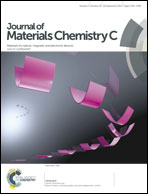Systematic study of TCTA-based star-shaped host materials by optimizing ratio of carbazole/ diphenylphosphine oxide: achieving both low efficiency roll-off and turn-on voltage for blue PHOLEDs
Abstract
A series of star-shaped host materials DCzPOTA, CzDPOTA and TCTA containing a central triphenylamine (TPA) core, a peripheral modification with different ratios of p-type carbazole units and n-type diphenylphosphine oxide (DPPO) units were purposefully designed and synthesized. Their electronic nature, electrochemical, thermal and morphological properties were investigated systematically. In suitable proportions of carbazole and phosphine oxide, blue PhOLEDs based on DCzPOTA exhibits a maximum power efficiency of 36.9 lm W−1 and an ideal turn-on voltage (2.7 V at 1 cd m−2). These results indicate that the electronic nature of the host material can be finely adjusted by gradually changing the donor–acceptor ratio.


 Please wait while we load your content...
Please wait while we load your content...